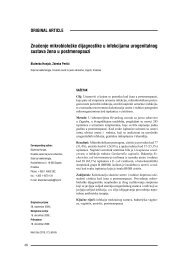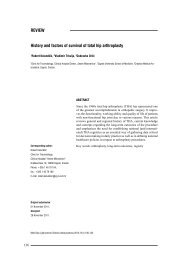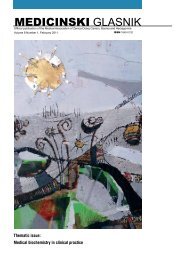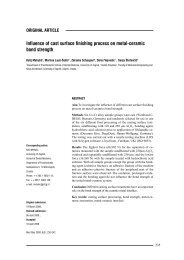MEDICINSKI GLASNIK
MEDICINSKI GLASNIK
MEDICINSKI GLASNIK
You also want an ePaper? Increase the reach of your titles
YUMPU automatically turns print PDFs into web optimized ePapers that Google loves.
prevention and health promotion, high alcohol<br />
consumers were rarely counselled to reduce or<br />
stop alcohol use. The importance of heavy drinking<br />
cessation is in well known relation to cardiovascular<br />
diseases, but also notably other diseases<br />
and injuries (25,26).<br />
To somewhat summarize the occurrence of<br />
risk factors we may say that in the middle aged<br />
males, the most prominent risk factor was smoking,<br />
followed by high blood pressure, obesity,<br />
inadequate nutrition and physical inactivity. The<br />
hierarchy was somewhat different in females,<br />
except smoking which has also been the leading<br />
risk factor in young females, followed by obesity<br />
in the middle aged, high blood pressure, physical<br />
inactivity and inadequate nutrition.<br />
Can the risk factors for CVD itself, without<br />
social determinants, correctly assess the situation<br />
and be used for health care policy recommendation?<br />
The risk assessment is important but insufficient.<br />
It would be sufficient if the effects of social<br />
determinants on appearance and outcome of<br />
cardiovascular disease were unknown. However,<br />
the facts and scientific analysis speak precisely<br />
the opposite (27). Socio-economic status (SES)<br />
is consistently among the most fundamental determinants<br />
of health status (28, 29). Furthermore,<br />
SES relationship can be attributed to CVDs together<br />
with combined effects of differences in<br />
health-related behaviours, environmental conditions,<br />
social structures, and the availability and<br />
delivery of health care (29). Our findings of low<br />
education status and low income in relation to high<br />
risk for CVDs is in agreement with the findings<br />
REFERENCES<br />
1.<br />
2.<br />
3.<br />
World Health Organization. European Health for<br />
all Database (HFA- DB). http:// www.euro.who.<br />
int/HFADB (5 June 2005).<br />
Croatian Central Bureau of Statistics, Statistical<br />
yearbook 2004. Zagreb: Croatian Central Bureau<br />
of Statistics, 2004.<br />
Strnad M. Čorić T. Kern J. Polašek O. Mortality<br />
due to Cardiovascular Diseases. In: Proceedings<br />
of the Symposium on Regional Distribution<br />
of Populations Cardiovascular Risk factors in<br />
Croatia, Zagreb, Croatia, 2nd December, 2005.<br />
Academy of Medical Science Croatia, Zagreb,<br />
Croatia, 2005, p.1.<br />
Malatestinićet al Smoking in the Croatian Western Region<br />
of other authors (5, 29). They also pinpointed that<br />
education and income-related disparity influenced<br />
particularly the tobacco use and diabetes prevalence.<br />
They occur more among the people with a<br />
lower SES. The step up in lowering the frequency<br />
of CVD risk factors, and the concomitant decrease<br />
in CVD mortality among the adults is a chronic<br />
disease success story in the United States (29). It<br />
produced further good news: at least with regard<br />
to trends in blood pressure and blood cholesterol<br />
level, people with low annual incomes and low education<br />
levels were not left behind. These findings<br />
stress the need for public health efforts in finding<br />
ways to reach population with lower SES.<br />
There are some limitations to our study. First,<br />
study was based on cross-sectional samples, thus<br />
not designed to assess cause and effect between<br />
SES and cardiovascular disease risk factors. Our<br />
goal was not to assess the cause, but to determine<br />
the population burden of CVD risk factors. Finally,<br />
our assessment of disease and risk factors<br />
depended on respondents’ ´ honesty.<br />
Still, thanks to the CAHS, evidence base for<br />
CVD prevention programme in Croatia and its<br />
regions was good, providing a national and regional<br />
guidance for prevention and health promotion<br />
in cardiovascular health. It emphasises<br />
the need for a holistic approach in the promotion<br />
of healthier lifestyles, especially reducing tobacco<br />
use and alcohol consumption and promoting<br />
healthy nutrition and physical activities.<br />
ACKNOWLEDGEMENT/DISCLOSURE<br />
4.<br />
5.<br />
Competing interests: none decleared.<br />
Beland Y, Bailie L, Page J. Statistics Canada,<br />
Croatian Ministry of Health, and Central Bureau<br />
of Statistics: a joint effort in implementing<br />
the 2003 Croatian Adult Health Survey. In: Proceedings<br />
of the American Statistical Association<br />
Meeting on survey research methods. Toronto,<br />
Canada, August 2004. American Statistical Association,<br />
Toronto, 2004.<br />
Lukenda J, Kolaric B, Kolčić I, Pažur V, Biloglav<br />
Z. Cardiovascular diseases in Croatia and other<br />
transitinal countries: comparative study of publications,<br />
clinical interventions, and burden of disease.<br />
Croat Med J 2005; 46:865-74.<br />
225












